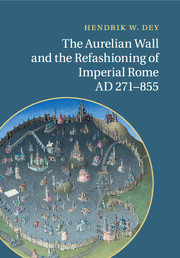Book contents
- Frontmatter
- Contents
- List of abbreviations
- List of figures
- Acknowledgements
- Introduction
- 1 Toward an architectural history of the Aurelian Wall, from its beginnings through the ninth century
- 2 Planning, building, rebuilding, and maintenance: the logistical dynamics of a (nearly) interminable project
- 3 Motives, meaning, and context: the Aurelian Wall and the late Roman state
- 4 The city, the suburbs, and the Wall: the rise of a topographical institution
- 5 Sacred geography, interrupted
- 6 The Wall and the “Republic of St. Peter”
- Conclusion
- Appendices
- Bibliography
- Index
1 - Toward an architectural history of the Aurelian Wall, from its beginnings through the ninth century
Published online by Cambridge University Press: 19 May 2011
- Frontmatter
- Contents
- List of abbreviations
- List of figures
- Acknowledgements
- Introduction
- 1 Toward an architectural history of the Aurelian Wall, from its beginnings through the ninth century
- 2 Planning, building, rebuilding, and maintenance: the logistical dynamics of a (nearly) interminable project
- 3 Motives, meaning, and context: the Aurelian Wall and the late Roman state
- 4 The city, the suburbs, and the Wall: the rise of a topographical institution
- 5 Sacred geography, interrupted
- 6 The Wall and the “Republic of St. Peter”
- Conclusion
- Appendices
- Bibliography
- Index
Summary
The basics: an overview
Though the process of identifying and dating the various phases of the Wall has consumed the large majority of the scholarly ink spilled since the time of Nibby at the beginning of the nineteenth century, the picture in its entirety really began to come into focus only with Richmond's study of 1930. Further significant advances have been made since his time, and still a number of vexed issues remain. The labor of identifying various bits of the Wall's fabric and ordering them in historically plausible sequences potentially spanning more than seventeen centuries is exceptionally challenging. Even relative chronologies can be difficult to establish in places, and the search for absolute dates is harder still. The process is often not unlike looking at a massively complex puzzle, mostly complete, and then trying to determine the order in which various bits were inserted. It is a work in progress: I have attempted to discuss the pieces already relatively securely fitted, by now the majority of the whole, and where possible to propose modifications and additions. For every advance that permits new linkages between the Wall's various construction phases and the temporal circumstances of their realization, it becomes more feasible to transcend these very architectural particulars, and to begin replacing the Wall in its historical context.
Hence, while the bulk of this study will in fact aim to replace the Wall in the grand narrative of Roman history, it will first be necessary to propose a chapter of detailed description and analysis of the structure, particularly because a reliable and up-to-date overview of its construction history and architectural particulars is currently lacking, above all in Anglophone circles, where reliance on Richmond and his later epitomator Todd remains nearly total.
- Type
- Chapter
- Information
- Publisher: Cambridge University PressPrint publication year: 2011



